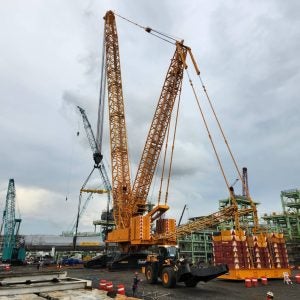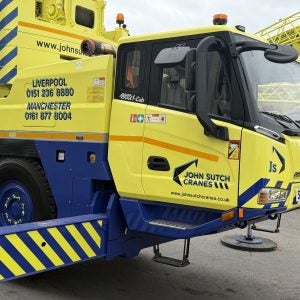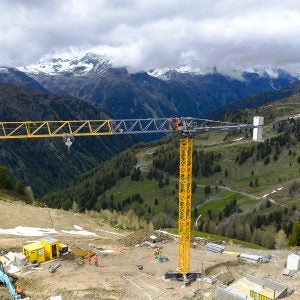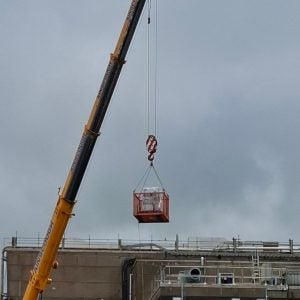The UK Construction Plant-hire Association has published three new technical information notes offering guidance on the use of the cranes in windy conditions, in the wake of a fatal accident in Liverpool. As first revealed in Cranes Today in July, the HSE identified the root cause of the accident as the luffing rope spooling out of the back of the crane, after the jib was momentarily held up at its minimum radius by a short gust of wind. This finding prompted comments from industry insiders that the HSE may call for changes to European standard EN 14439, to tighten specification for anti-spooling devices on these types of cranes
The three new technical information notes (TINs) aim to help the industry to learn from the HSE’s findings. The first, CPA tower crane interest group TIN 023, is aimed at crane owners. It sets out a series of questions crane owners should ask about their fleet, to see if it could be susceptible to the same problems. If it could be, fleet owners are advised to check that operating instructions adequately address minimum radius conditions and the lifting of light loads. If they do not, owners should ask manufacturers to review and amend their instructions.
Owners should list and assess the control measures used to stop ropes coming off of sheaves, by, for example, measuring any gaps between any gap between the sheave guard and sheave flanges. If necessary, owners should speak to manufacturers about their findings, and work with them on making changes.
They should also list the protective and limiting devices provided to sense luffing rope conditions. The TIN says these may include rope proximity detection devices and luffing winch torque measuring systems. Again, owners should risk assess this equipment, and speak to manufacturers if they have any doubts over it.
As well as these risk assessments, the crane owners should work others involved in using these cranes. They should speak to their operators, and make sure they are aware of the Liverpool incident and the probable cause so that they are aware of the problems of operating in high winds with light loads at minimum radius. Working with operators, they should devise safety procedures for recovery in the case of a luffing jib being blown back or held up by the wind.
Crane owners should also communicate with users such as principal contractors and appointed persons, the TIN says. Again, they should all be made aware of the Liverpool accident and the HSE’s findings. The crane owner should establish the steps they need to take when managing lifting at or near minimum radius with luffing jib tower cranes.
The second TIN, 024, is aimed at these users. It tells them that particular care should be taken when planning lifts which require the lifting of light loads at or near the minimum radius of a luffing jib tower crane. The luffing rope should be under tension at all times. When lifting very light loads it may be appropriate to add additional ‘dead’ weight to the hook block or load. This should be undertaken in consultation with the crane supplier.
Particular care should be taken when operating in gusty wind conditions, taking into account the specific characteristics of the site. Before the start of each shift the operator should ensure that the anemometer is functioning. Steps should be taken to ensure that any safety devices fitted to the crane are functioning properly. This will normally be accomplished by consultation with the crane supplier.
The competence and experience of the appointed person should be verified to ensure that they are able to manage lifting operations involving luffing cranes effectively. Luffing jib tower crane operators should be asked if they are aware of the measures they should take in the event of a luffing jib being held up by wind.
The final TIN, 025, is aimed at crane operators. It repeats the advice from TIN 024, highlighting the risks of operating luffing jibs in gusty conditions. It also gives advice on the specific steps operators should take if a crane’s jib doesn’t move down when the luffing control is operated. It says operators should immediately release the luffing winch control, and then:
1.Ensure that the load, hook block and hoist rope are hanging free;
2.Carefully slew away from the wind through between 90° to 180°;
3.Carefully attempt to luff down;
4.If the jib does not move, immediately release the luffing winch control, report the situation
5.to your supervisor and await instructions.
6.If the jib does move, report the situation to your supervisor and await instructions.
The first TIN, 023, includes an annex, with the HSE’s findings on the accident. They describe the causes of the accident as follows: “As the crane was lifting a light load at minimum radius with its jib almost vertical it would be more susceptible to wind loading especially when facing in to the wind. A single gust of wind is unlikely to have lasted long enough to hold the jib in a hung position or to lift the jib by a large amount but even a short duration gust may have been enough to lift the jib momentarily, causing tension to be released in the luffing rope.
“The rope could have jumped from one or more of the pulleys in the fixed pulley block and/ or the flying block of the luffing mechanism and become jammed. Alternatively the luffing rope could have come off one or more of the pulleys in the fixed pulley block and/ or the flying block for some other reason, e.g. because of disintegration of the blocks’ components or mis-tracking of the rope on the pulley whilst at reduced tension due to reasons other than wind. The design of the protective device on the fixed block – the single bar – was not adequate to prevent the rope from coming off the pulleys and jump into the gaps between them.
“As the wind gust subsided, the jib, under gravity, restored tension on the luffing rope causing it to jam between the pulleys and the casings of the blocks. This resulted in the jib hanging in a position near to minimum radius. With the luffing rope jammed the driver then attempted to lower the jib and, possibly, slew the crane, unaware that the jammed luffing rope was winding out behind him creating a loop of slack rope.
“The subsequent freeing of the luffing rope could have occurred because of disintegration of the block components. However, there is some evidence the load, a relatively light reinforcing cage for a concrete column, became jammed against something – most likely the lighting rig on the crane tower.
“The observed slewing of the crane would be consistent with the crane operator turning the jib away from the direction of the wind: normal practice if a jib is held up by the wind. Slewing with a snagged load would have put tension into the hoist rope. We believe that the slewing motion either by itself, or possibly combined with the load suddenly freeing, imparted sufficient force to free the jammed luffing rope. Release of the hoist rope after it was in tension would also account for the rope snaking around the adjoining car park.
“Once the luffing rope was freed the jib would then go in to free-fall until its downward movement was halted as the slack in the luffing rope was taken up. The elasticity present in the luffing rope and other components then imparted an oscillating movement in the jib, creating high dynamic shock loading throughout the entire structure.
“This loading would be sufficient to cause the jib to bend, slewing ring bolts to fail, the slewing ring to fracture and the two tower pins to shear. As the crane assembly toppled over the counterweights that normally would have been held in position by their own weight, fell out.”
The two counterweights struck Zbigniew Swirzynski, who was working below. Swirzynski was killed in the accident, and the operator, Barry Walker, had to be cut from his cab by the fire brigade.
Related Files
CPA TC-IG 023: For owners of luffing jib cranes
CPA TC-IG 024: For users of luffing jib cranes
CPA TC-IG 025: For operators of luffing jib cranes






